Essay: Evaluating Educational Provision and Process
VerifiedAdded on 2022/01/06
|24
|6886
|27
Essay
AI Summary
This essay critically evaluates orthodox educational provision and processes, reflecting on an example of educational practice and policies. It analyzes an image depicting children learning through play, emphasizing this as a key educational context. The essay explores multiple intelligences theory, European education systems, philosophies of learning, and professional development in education. It examines the strengths and weaknesses of these themes, providing insights into current educational practices and provisions. The analysis includes discussions on the educational context of learning by playing, the theory of multiple intelligences, and the need for professional development in education. The essay provides a detailed overview of the current education system, the shortcomings, and the need for improvement.
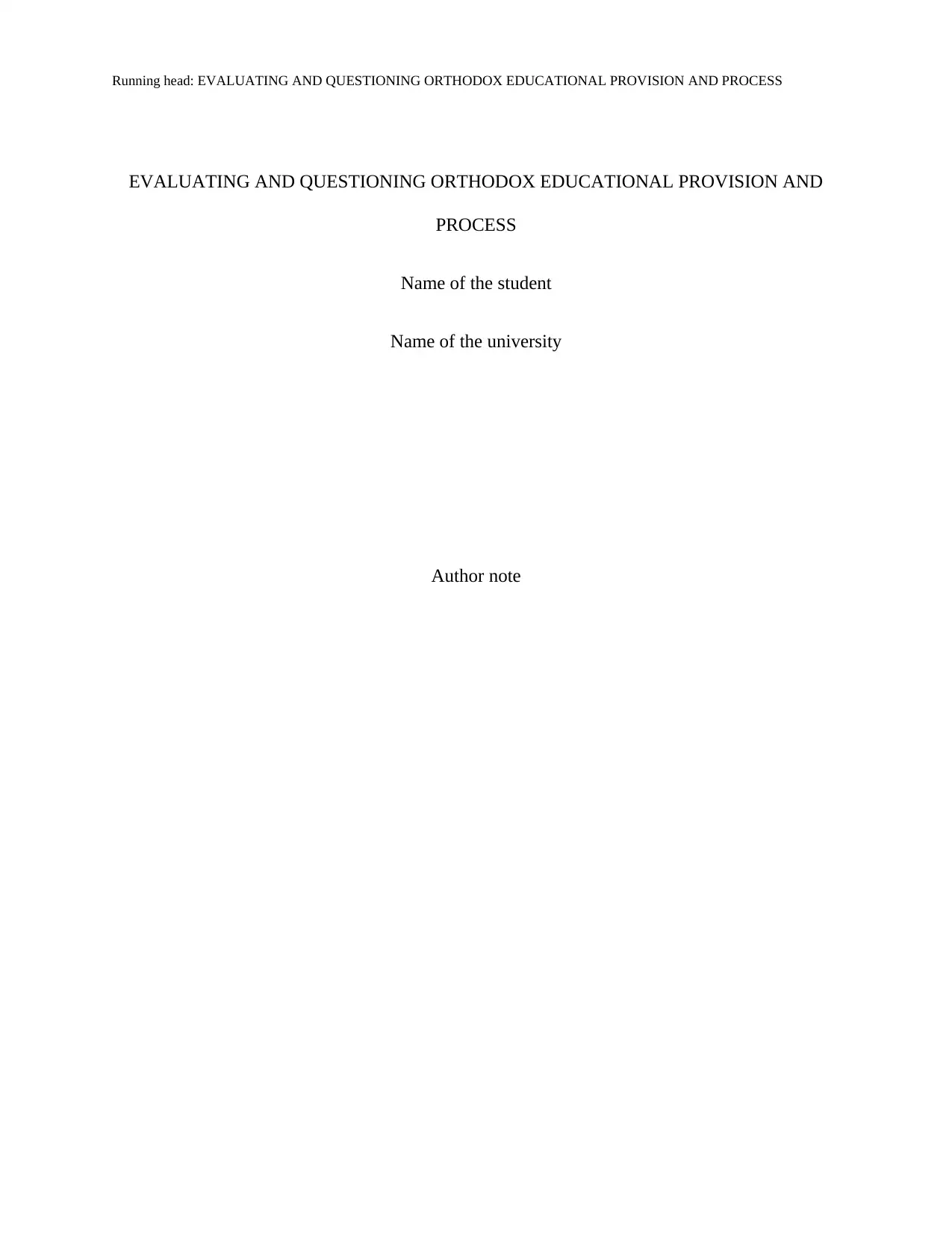
Running head: EVALUATING AND QUESTIONING ORTHODOX EDUCATIONAL PROVISION AND PROCESS
EVALUATING AND QUESTIONING ORTHODOX EDUCATIONAL PROVISION AND
PROCESS
Name of the student
Name of the university
Author note
EVALUATING AND QUESTIONING ORTHODOX EDUCATIONAL PROVISION AND
PROCESS
Name of the student
Name of the university
Author note
Paraphrase This Document
Need a fresh take? Get an instant paraphrase of this document with our AI Paraphraser
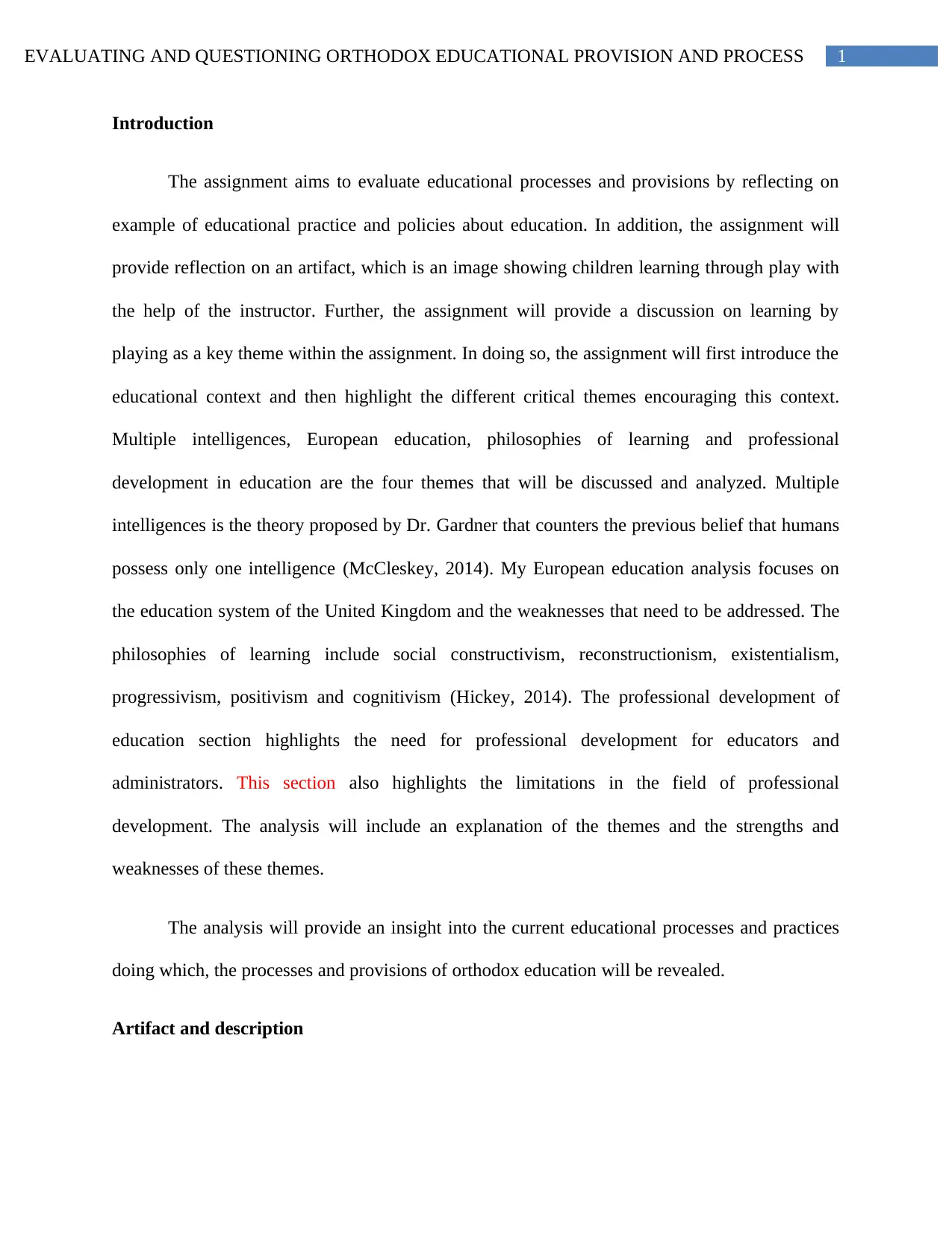
1EVALUATING AND QUESTIONING ORTHODOX EDUCATIONAL PROVISION AND PROCESS
Introduction
The assignment aims to evaluate educational processes and provisions by reflecting on
example of educational practice and policies about education. In addition, the assignment will
provide reflection on an artifact, which is an image showing children learning through play with
the help of the instructor. Further, the assignment will provide a discussion on learning by
playing as a key theme within the assignment. In doing so, the assignment will first introduce the
educational context and then highlight the different critical themes encouraging this context.
Multiple intelligences, European education, philosophies of learning and professional
development in education are the four themes that will be discussed and analyzed. Multiple
intelligences is the theory proposed by Dr. Gardner that counters the previous belief that humans
possess only one intelligence (McCleskey, 2014). My European education analysis focuses on
the education system of the United Kingdom and the weaknesses that need to be addressed. The
philosophies of learning include social constructivism, reconstructionism, existentialism,
progressivism, positivism and cognitivism (Hickey, 2014). The professional development of
education section highlights the need for professional development for educators and
administrators. This section also highlights the limitations in the field of professional
development. The analysis will include an explanation of the themes and the strengths and
weaknesses of these themes.
The analysis will provide an insight into the current educational processes and practices
doing which, the processes and provisions of orthodox education will be revealed.
Artifact and description
Introduction
The assignment aims to evaluate educational processes and provisions by reflecting on
example of educational practice and policies about education. In addition, the assignment will
provide reflection on an artifact, which is an image showing children learning through play with
the help of the instructor. Further, the assignment will provide a discussion on learning by
playing as a key theme within the assignment. In doing so, the assignment will first introduce the
educational context and then highlight the different critical themes encouraging this context.
Multiple intelligences, European education, philosophies of learning and professional
development in education are the four themes that will be discussed and analyzed. Multiple
intelligences is the theory proposed by Dr. Gardner that counters the previous belief that humans
possess only one intelligence (McCleskey, 2014). My European education analysis focuses on
the education system of the United Kingdom and the weaknesses that need to be addressed. The
philosophies of learning include social constructivism, reconstructionism, existentialism,
progressivism, positivism and cognitivism (Hickey, 2014). The professional development of
education section highlights the need for professional development for educators and
administrators. This section also highlights the limitations in the field of professional
development. The analysis will include an explanation of the themes and the strengths and
weaknesses of these themes.
The analysis will provide an insight into the current educational processes and practices
doing which, the processes and provisions of orthodox education will be revealed.
Artifact and description
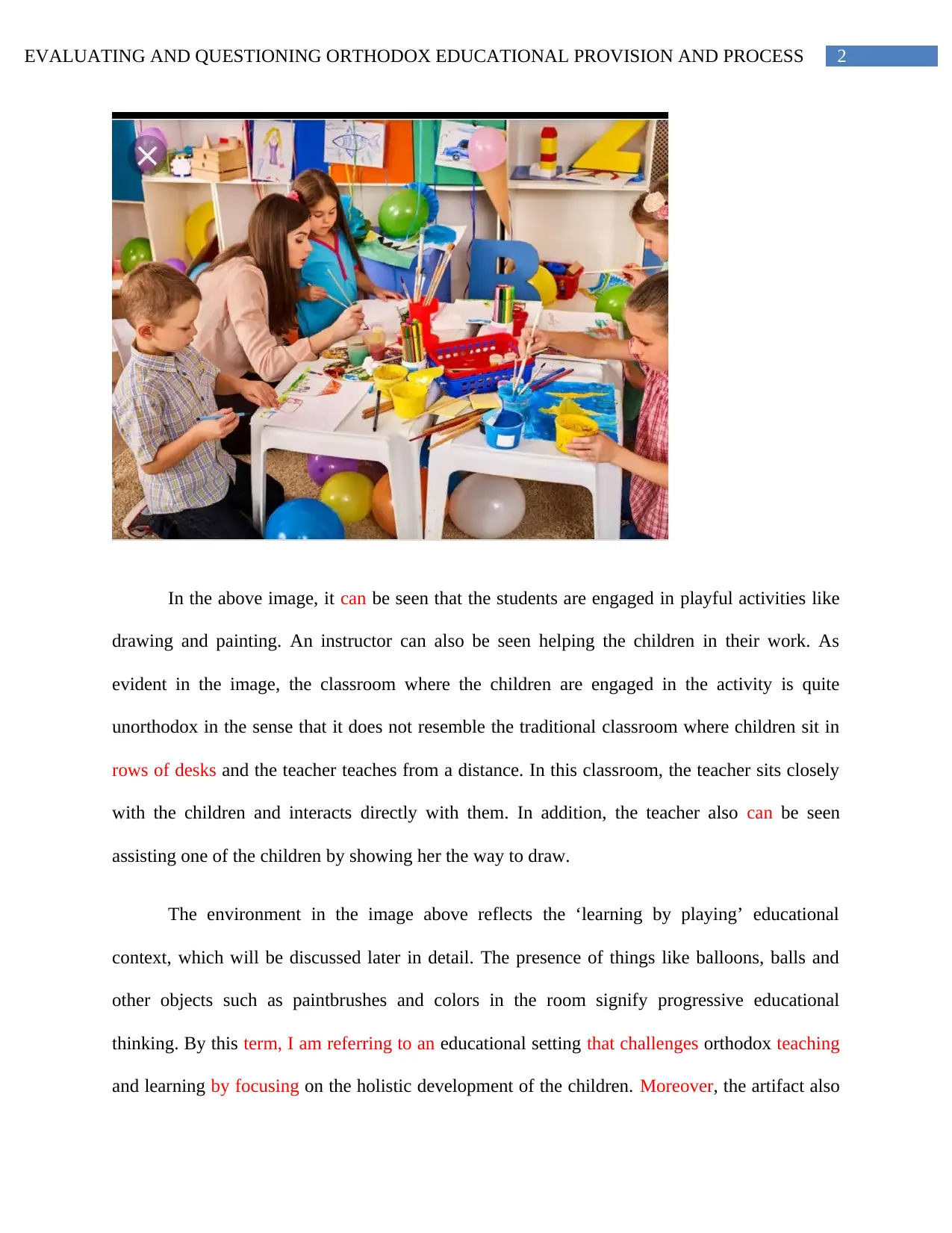
2EVALUATING AND QUESTIONING ORTHODOX EDUCATIONAL PROVISION AND PROCESS
In the above image, it can be seen that the students are engaged in playful activities like
drawing and painting. An instructor can also be seen helping the children in their work. As
evident in the image, the classroom where the children are engaged in the activity is quite
unorthodox in the sense that it does not resemble the traditional classroom where children sit in
rows of desks and the teacher teaches from a distance. In this classroom, the teacher sits closely
with the children and interacts directly with them. In addition, the teacher also can be seen
assisting one of the children by showing her the way to draw.
The environment in the image above reflects the ‘learning by playing’ educational
context, which will be discussed later in detail. The presence of things like balloons, balls and
other objects such as paintbrushes and colors in the room signify progressive educational
thinking. By this term, I am referring to an educational setting that challenges orthodox teaching
and learning by focusing on the holistic development of the children. Moreover, the artifact also
In the above image, it can be seen that the students are engaged in playful activities like
drawing and painting. An instructor can also be seen helping the children in their work. As
evident in the image, the classroom where the children are engaged in the activity is quite
unorthodox in the sense that it does not resemble the traditional classroom where children sit in
rows of desks and the teacher teaches from a distance. In this classroom, the teacher sits closely
with the children and interacts directly with them. In addition, the teacher also can be seen
assisting one of the children by showing her the way to draw.
The environment in the image above reflects the ‘learning by playing’ educational
context, which will be discussed later in detail. The presence of things like balloons, balls and
other objects such as paintbrushes and colors in the room signify progressive educational
thinking. By this term, I am referring to an educational setting that challenges orthodox teaching
and learning by focusing on the holistic development of the children. Moreover, the artifact also
⊘ This is a preview!⊘
Do you want full access?
Subscribe today to unlock all pages.

Trusted by 1+ million students worldwide
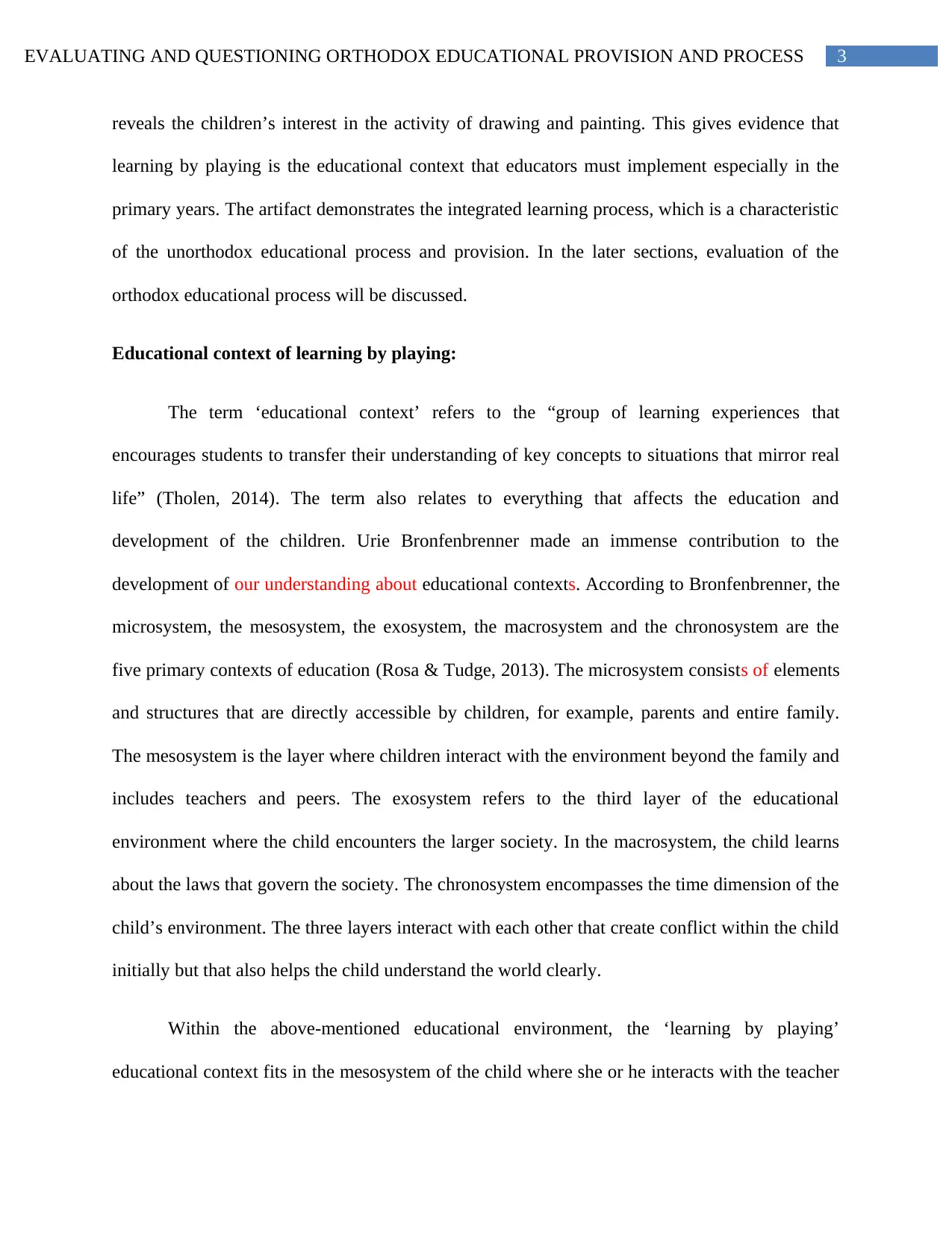
3EVALUATING AND QUESTIONING ORTHODOX EDUCATIONAL PROVISION AND PROCESS
reveals the children’s interest in the activity of drawing and painting. This gives evidence that
learning by playing is the educational context that educators must implement especially in the
primary years. The artifact demonstrates the integrated learning process, which is a characteristic
of the unorthodox educational process and provision. In the later sections, evaluation of the
orthodox educational process will be discussed.
Educational context of learning by playing:
The term ‘educational context’ refers to the “group of learning experiences that
encourages students to transfer their understanding of key concepts to situations that mirror real
life” (Tholen, 2014). The term also relates to everything that affects the education and
development of the children. Urie Bronfenbrenner made an immense contribution to the
development of our understanding about educational contexts. According to Bronfenbrenner, the
microsystem, the mesosystem, the exosystem, the macrosystem and the chronosystem are the
five primary contexts of education (Rosa & Tudge, 2013). The microsystem consists of elements
and structures that are directly accessible by children, for example, parents and entire family.
The mesosystem is the layer where children interact with the environment beyond the family and
includes teachers and peers. The exosystem refers to the third layer of the educational
environment where the child encounters the larger society. In the macrosystem, the child learns
about the laws that govern the society. The chronosystem encompasses the time dimension of the
child’s environment. The three layers interact with each other that create conflict within the child
initially but that also helps the child understand the world clearly.
Within the above-mentioned educational environment, the ‘learning by playing’
educational context fits in the mesosystem of the child where she or he interacts with the teacher
reveals the children’s interest in the activity of drawing and painting. This gives evidence that
learning by playing is the educational context that educators must implement especially in the
primary years. The artifact demonstrates the integrated learning process, which is a characteristic
of the unorthodox educational process and provision. In the later sections, evaluation of the
orthodox educational process will be discussed.
Educational context of learning by playing:
The term ‘educational context’ refers to the “group of learning experiences that
encourages students to transfer their understanding of key concepts to situations that mirror real
life” (Tholen, 2014). The term also relates to everything that affects the education and
development of the children. Urie Bronfenbrenner made an immense contribution to the
development of our understanding about educational contexts. According to Bronfenbrenner, the
microsystem, the mesosystem, the exosystem, the macrosystem and the chronosystem are the
five primary contexts of education (Rosa & Tudge, 2013). The microsystem consists of elements
and structures that are directly accessible by children, for example, parents and entire family.
The mesosystem is the layer where children interact with the environment beyond the family and
includes teachers and peers. The exosystem refers to the third layer of the educational
environment where the child encounters the larger society. In the macrosystem, the child learns
about the laws that govern the society. The chronosystem encompasses the time dimension of the
child’s environment. The three layers interact with each other that create conflict within the child
initially but that also helps the child understand the world clearly.
Within the above-mentioned educational environment, the ‘learning by playing’
educational context fits in the mesosystem of the child where she or he interacts with the teacher
Paraphrase This Document
Need a fresh take? Get an instant paraphrase of this document with our AI Paraphraser
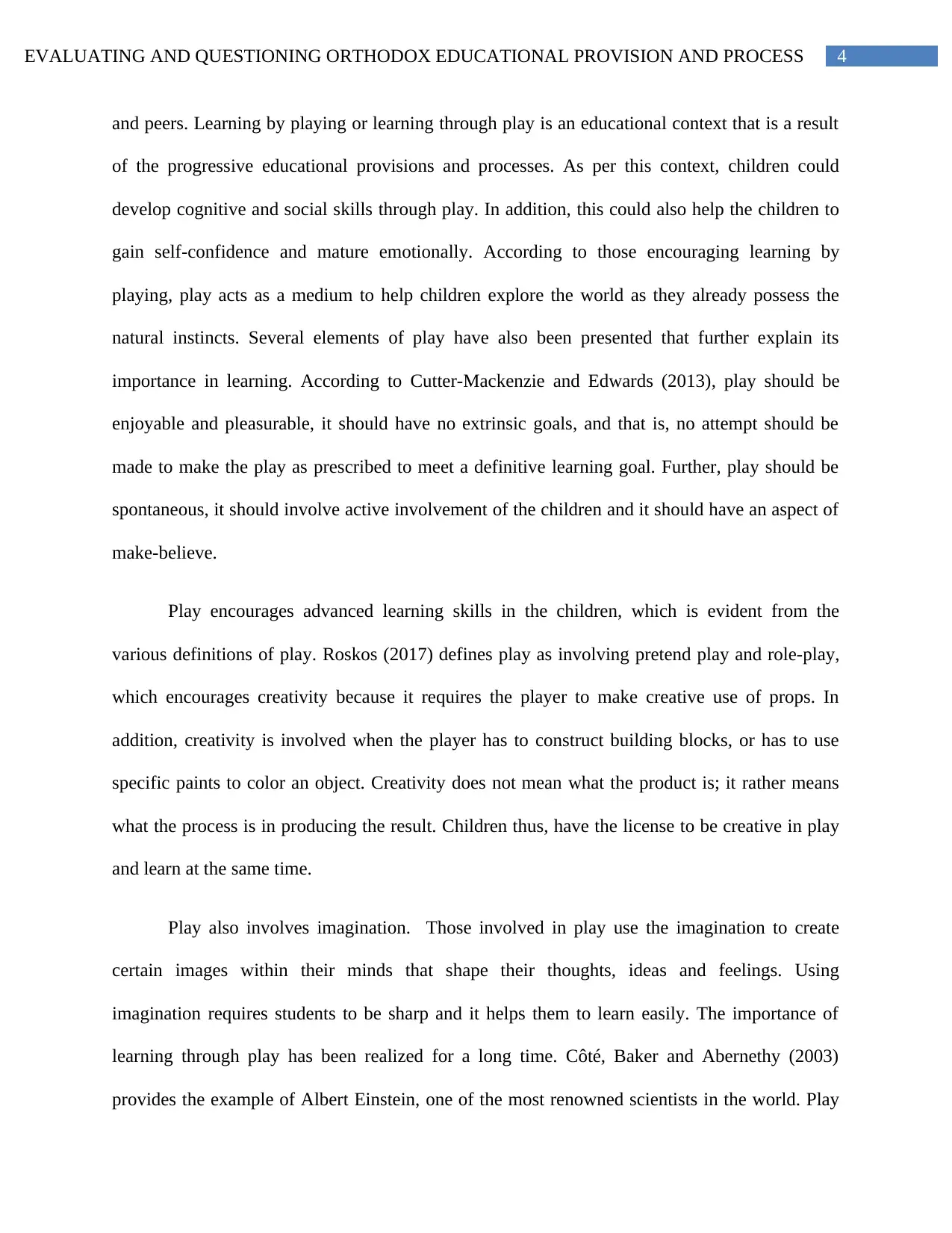
4EVALUATING AND QUESTIONING ORTHODOX EDUCATIONAL PROVISION AND PROCESS
and peers. Learning by playing or learning through play is an educational context that is a result
of the progressive educational provisions and processes. As per this context, children could
develop cognitive and social skills through play. In addition, this could also help the children to
gain self-confidence and mature emotionally. According to those encouraging learning by
playing, play acts as a medium to help children explore the world as they already possess the
natural instincts. Several elements of play have also been presented that further explain its
importance in learning. According to Cutter-Mackenzie and Edwards (2013), play should be
enjoyable and pleasurable, it should have no extrinsic goals, and that is, no attempt should be
made to make the play as prescribed to meet a definitive learning goal. Further, play should be
spontaneous, it should involve active involvement of the children and it should have an aspect of
make-believe.
Play encourages advanced learning skills in the children, which is evident from the
various definitions of play. Roskos (2017) defines play as involving pretend play and role-play,
which encourages creativity because it requires the player to make creative use of props. In
addition, creativity is involved when the player has to construct building blocks, or has to use
specific paints to color an object. Creativity does not mean what the product is; it rather means
what the process is in producing the result. Children thus, have the license to be creative in play
and learn at the same time.
Play also involves imagination. Those involved in play use the imagination to create
certain images within their minds that shape their thoughts, ideas and feelings. Using
imagination requires students to be sharp and it helps them to learn easily. The importance of
learning through play has been realized for a long time. Côté, Baker and Abernethy (2003)
provides the example of Albert Einstein, one of the most renowned scientists in the world. Play
and peers. Learning by playing or learning through play is an educational context that is a result
of the progressive educational provisions and processes. As per this context, children could
develop cognitive and social skills through play. In addition, this could also help the children to
gain self-confidence and mature emotionally. According to those encouraging learning by
playing, play acts as a medium to help children explore the world as they already possess the
natural instincts. Several elements of play have also been presented that further explain its
importance in learning. According to Cutter-Mackenzie and Edwards (2013), play should be
enjoyable and pleasurable, it should have no extrinsic goals, and that is, no attempt should be
made to make the play as prescribed to meet a definitive learning goal. Further, play should be
spontaneous, it should involve active involvement of the children and it should have an aspect of
make-believe.
Play encourages advanced learning skills in the children, which is evident from the
various definitions of play. Roskos (2017) defines play as involving pretend play and role-play,
which encourages creativity because it requires the player to make creative use of props. In
addition, creativity is involved when the player has to construct building blocks, or has to use
specific paints to color an object. Creativity does not mean what the product is; it rather means
what the process is in producing the result. Children thus, have the license to be creative in play
and learn at the same time.
Play also involves imagination. Those involved in play use the imagination to create
certain images within their minds that shape their thoughts, ideas and feelings. Using
imagination requires students to be sharp and it helps them to learn easily. The importance of
learning through play has been realized for a long time. Côté, Baker and Abernethy (2003)
provides the example of Albert Einstein, one of the most renowned scientists in the world. Play
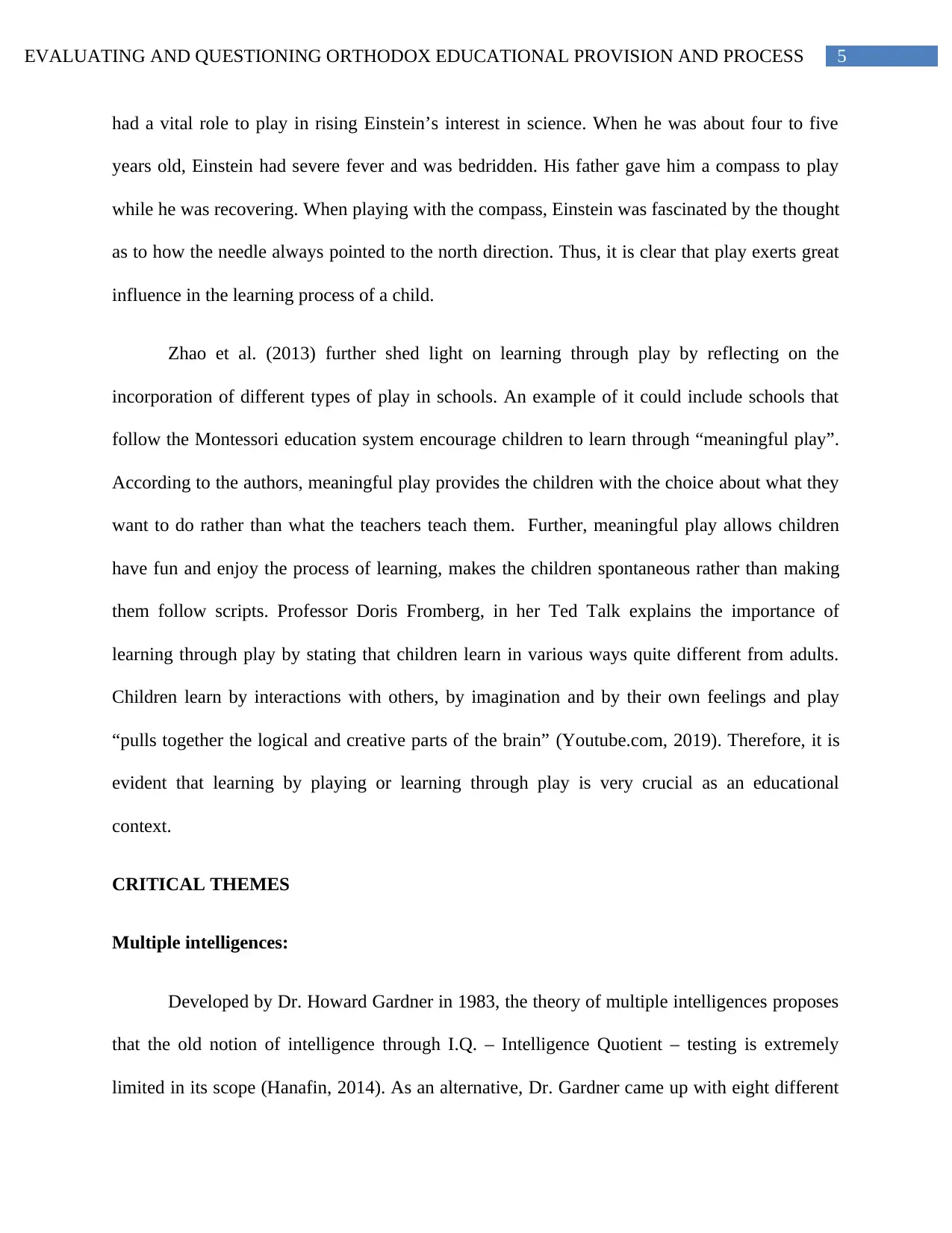
5EVALUATING AND QUESTIONING ORTHODOX EDUCATIONAL PROVISION AND PROCESS
had a vital role to play in rising Einstein’s interest in science. When he was about four to five
years old, Einstein had severe fever and was bedridden. His father gave him a compass to play
while he was recovering. When playing with the compass, Einstein was fascinated by the thought
as to how the needle always pointed to the north direction. Thus, it is clear that play exerts great
influence in the learning process of a child.
Zhao et al. (2013) further shed light on learning through play by reflecting on the
incorporation of different types of play in schools. An example of it could include schools that
follow the Montessori education system encourage children to learn through “meaningful play”.
According to the authors, meaningful play provides the children with the choice about what they
want to do rather than what the teachers teach them. Further, meaningful play allows children
have fun and enjoy the process of learning, makes the children spontaneous rather than making
them follow scripts. Professor Doris Fromberg, in her Ted Talk explains the importance of
learning through play by stating that children learn in various ways quite different from adults.
Children learn by interactions with others, by imagination and by their own feelings and play
“pulls together the logical and creative parts of the brain” (Youtube.com, 2019). Therefore, it is
evident that learning by playing or learning through play is very crucial as an educational
context.
CRITICAL THEMES
Multiple intelligences:
Developed by Dr. Howard Gardner in 1983, the theory of multiple intelligences proposes
that the old notion of intelligence through I.Q. – Intelligence Quotient – testing is extremely
limited in its scope (Hanafin, 2014). As an alternative, Dr. Gardner came up with eight different
had a vital role to play in rising Einstein’s interest in science. When he was about four to five
years old, Einstein had severe fever and was bedridden. His father gave him a compass to play
while he was recovering. When playing with the compass, Einstein was fascinated by the thought
as to how the needle always pointed to the north direction. Thus, it is clear that play exerts great
influence in the learning process of a child.
Zhao et al. (2013) further shed light on learning through play by reflecting on the
incorporation of different types of play in schools. An example of it could include schools that
follow the Montessori education system encourage children to learn through “meaningful play”.
According to the authors, meaningful play provides the children with the choice about what they
want to do rather than what the teachers teach them. Further, meaningful play allows children
have fun and enjoy the process of learning, makes the children spontaneous rather than making
them follow scripts. Professor Doris Fromberg, in her Ted Talk explains the importance of
learning through play by stating that children learn in various ways quite different from adults.
Children learn by interactions with others, by imagination and by their own feelings and play
“pulls together the logical and creative parts of the brain” (Youtube.com, 2019). Therefore, it is
evident that learning by playing or learning through play is very crucial as an educational
context.
CRITICAL THEMES
Multiple intelligences:
Developed by Dr. Howard Gardner in 1983, the theory of multiple intelligences proposes
that the old notion of intelligence through I.Q. – Intelligence Quotient – testing is extremely
limited in its scope (Hanafin, 2014). As an alternative, Dr. Gardner came up with eight different
⊘ This is a preview!⊘
Do you want full access?
Subscribe today to unlock all pages.

Trusted by 1+ million students worldwide
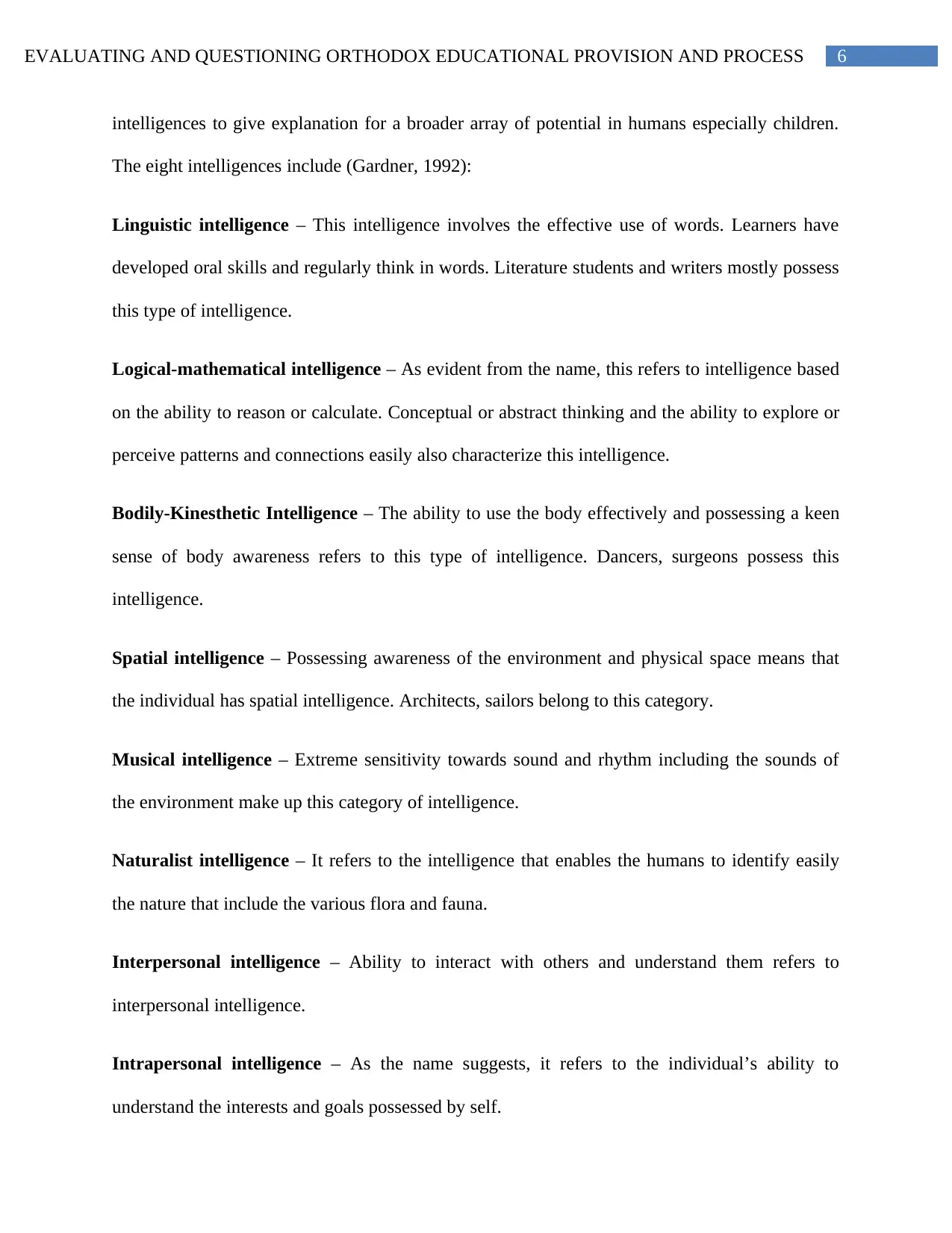
6EVALUATING AND QUESTIONING ORTHODOX EDUCATIONAL PROVISION AND PROCESS
intelligences to give explanation for a broader array of potential in humans especially children.
The eight intelligences include (Gardner, 1992):
Linguistic intelligence – This intelligence involves the effective use of words. Learners have
developed oral skills and regularly think in words. Literature students and writers mostly possess
this type of intelligence.
Logical-mathematical intelligence – As evident from the name, this refers to intelligence based
on the ability to reason or calculate. Conceptual or abstract thinking and the ability to explore or
perceive patterns and connections easily also characterize this intelligence.
Bodily-Kinesthetic Intelligence – The ability to use the body effectively and possessing a keen
sense of body awareness refers to this type of intelligence. Dancers, surgeons possess this
intelligence.
Spatial intelligence – Possessing awareness of the environment and physical space means that
the individual has spatial intelligence. Architects, sailors belong to this category.
Musical intelligence – Extreme sensitivity towards sound and rhythm including the sounds of
the environment make up this category of intelligence.
Naturalist intelligence – It refers to the intelligence that enables the humans to identify easily
the nature that include the various flora and fauna.
Interpersonal intelligence – Ability to interact with others and understand them refers to
interpersonal intelligence.
Intrapersonal intelligence – As the name suggests, it refers to the individual’s ability to
understand the interests and goals possessed by self.
intelligences to give explanation for a broader array of potential in humans especially children.
The eight intelligences include (Gardner, 1992):
Linguistic intelligence – This intelligence involves the effective use of words. Learners have
developed oral skills and regularly think in words. Literature students and writers mostly possess
this type of intelligence.
Logical-mathematical intelligence – As evident from the name, this refers to intelligence based
on the ability to reason or calculate. Conceptual or abstract thinking and the ability to explore or
perceive patterns and connections easily also characterize this intelligence.
Bodily-Kinesthetic Intelligence – The ability to use the body effectively and possessing a keen
sense of body awareness refers to this type of intelligence. Dancers, surgeons possess this
intelligence.
Spatial intelligence – Possessing awareness of the environment and physical space means that
the individual has spatial intelligence. Architects, sailors belong to this category.
Musical intelligence – Extreme sensitivity towards sound and rhythm including the sounds of
the environment make up this category of intelligence.
Naturalist intelligence – It refers to the intelligence that enables the humans to identify easily
the nature that include the various flora and fauna.
Interpersonal intelligence – Ability to interact with others and understand them refers to
interpersonal intelligence.
Intrapersonal intelligence – As the name suggests, it refers to the individual’s ability to
understand the interests and goals possessed by self.
Paraphrase This Document
Need a fresh take? Get an instant paraphrase of this document with our AI Paraphraser
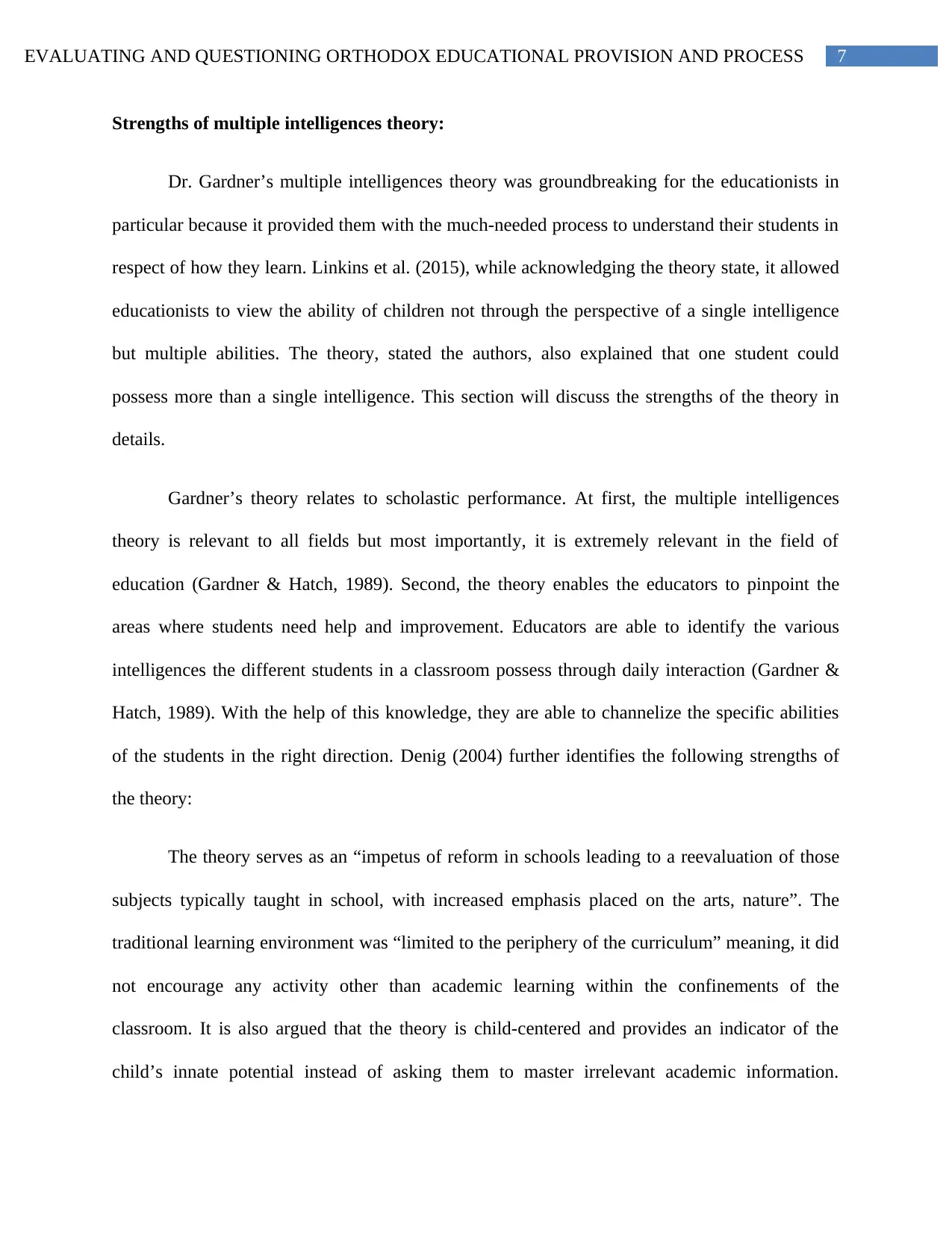
7EVALUATING AND QUESTIONING ORTHODOX EDUCATIONAL PROVISION AND PROCESS
Strengths of multiple intelligences theory:
Dr. Gardner’s multiple intelligences theory was groundbreaking for the educationists in
particular because it provided them with the much-needed process to understand their students in
respect of how they learn. Linkins et al. (2015), while acknowledging the theory state, it allowed
educationists to view the ability of children not through the perspective of a single intelligence
but multiple abilities. The theory, stated the authors, also explained that one student could
possess more than a single intelligence. This section will discuss the strengths of the theory in
details.
Gardner’s theory relates to scholastic performance. At first, the multiple intelligences
theory is relevant to all fields but most importantly, it is extremely relevant in the field of
education (Gardner & Hatch, 1989). Second, the theory enables the educators to pinpoint the
areas where students need help and improvement. Educators are able to identify the various
intelligences the different students in a classroom possess through daily interaction (Gardner &
Hatch, 1989). With the help of this knowledge, they are able to channelize the specific abilities
of the students in the right direction. Denig (2004) further identifies the following strengths of
the theory:
The theory serves as an “impetus of reform in schools leading to a reevaluation of those
subjects typically taught in school, with increased emphasis placed on the arts, nature”. The
traditional learning environment was “limited to the periphery of the curriculum” meaning, it did
not encourage any activity other than academic learning within the confinements of the
classroom. It is also argued that the theory is child-centered and provides an indicator of the
child’s innate potential instead of asking them to master irrelevant academic information.
Strengths of multiple intelligences theory:
Dr. Gardner’s multiple intelligences theory was groundbreaking for the educationists in
particular because it provided them with the much-needed process to understand their students in
respect of how they learn. Linkins et al. (2015), while acknowledging the theory state, it allowed
educationists to view the ability of children not through the perspective of a single intelligence
but multiple abilities. The theory, stated the authors, also explained that one student could
possess more than a single intelligence. This section will discuss the strengths of the theory in
details.
Gardner’s theory relates to scholastic performance. At first, the multiple intelligences
theory is relevant to all fields but most importantly, it is extremely relevant in the field of
education (Gardner & Hatch, 1989). Second, the theory enables the educators to pinpoint the
areas where students need help and improvement. Educators are able to identify the various
intelligences the different students in a classroom possess through daily interaction (Gardner &
Hatch, 1989). With the help of this knowledge, they are able to channelize the specific abilities
of the students in the right direction. Denig (2004) further identifies the following strengths of
the theory:
The theory serves as an “impetus of reform in schools leading to a reevaluation of those
subjects typically taught in school, with increased emphasis placed on the arts, nature”. The
traditional learning environment was “limited to the periphery of the curriculum” meaning, it did
not encourage any activity other than academic learning within the confinements of the
classroom. It is also argued that the theory is child-centered and provides an indicator of the
child’s innate potential instead of asking them to master irrelevant academic information.
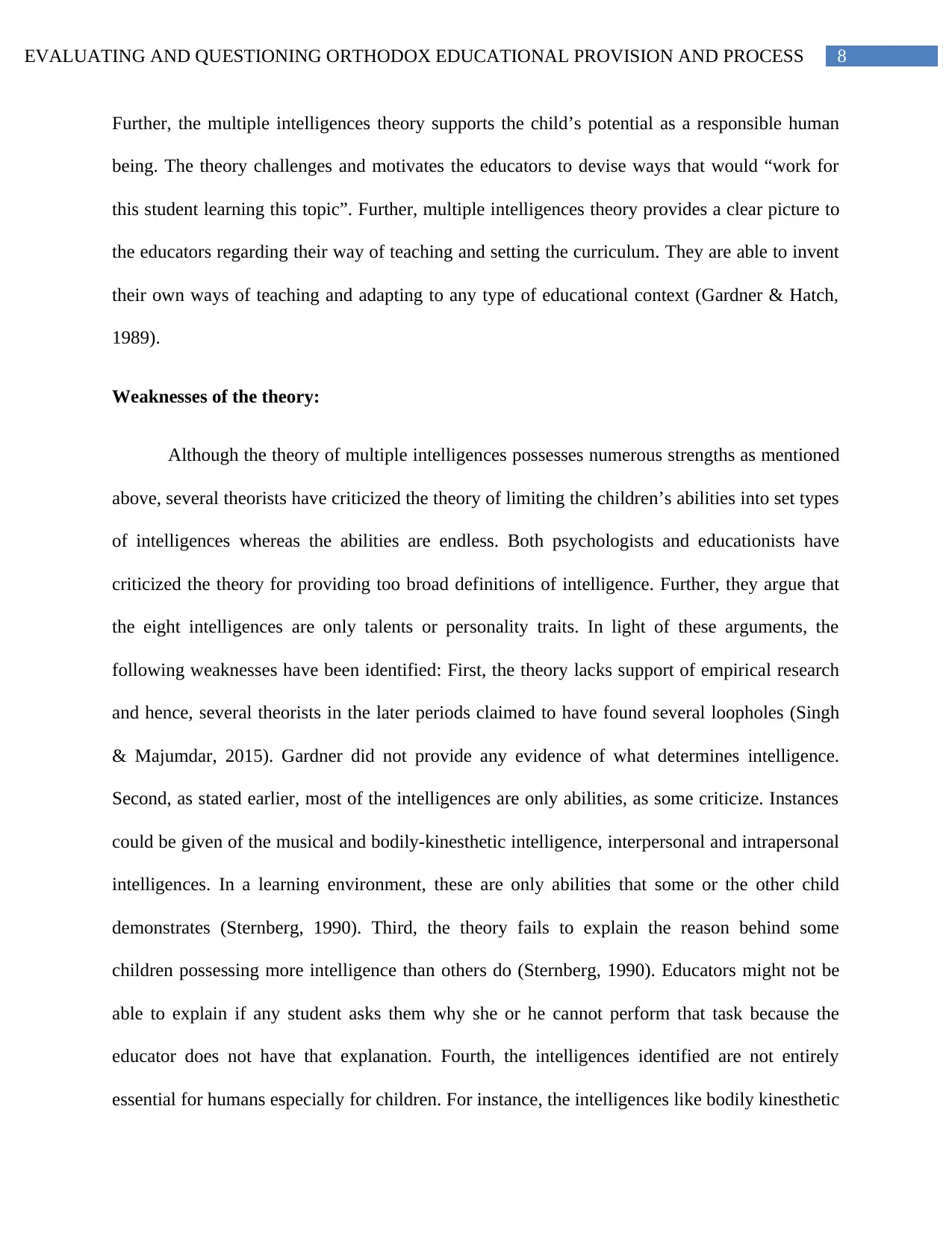
8EVALUATING AND QUESTIONING ORTHODOX EDUCATIONAL PROVISION AND PROCESS
Further, the multiple intelligences theory supports the child’s potential as a responsible human
being. The theory challenges and motivates the educators to devise ways that would “work for
this student learning this topic”. Further, multiple intelligences theory provides a clear picture to
the educators regarding their way of teaching and setting the curriculum. They are able to invent
their own ways of teaching and adapting to any type of educational context (Gardner & Hatch,
1989).
Weaknesses of the theory:
Although the theory of multiple intelligences possesses numerous strengths as mentioned
above, several theorists have criticized the theory of limiting the children’s abilities into set types
of intelligences whereas the abilities are endless. Both psychologists and educationists have
criticized the theory for providing too broad definitions of intelligence. Further, they argue that
the eight intelligences are only talents or personality traits. In light of these arguments, the
following weaknesses have been identified: First, the theory lacks support of empirical research
and hence, several theorists in the later periods claimed to have found several loopholes (Singh
& Majumdar, 2015). Gardner did not provide any evidence of what determines intelligence.
Second, as stated earlier, most of the intelligences are only abilities, as some criticize. Instances
could be given of the musical and bodily-kinesthetic intelligence, interpersonal and intrapersonal
intelligences. In a learning environment, these are only abilities that some or the other child
demonstrates (Sternberg, 1990). Third, the theory fails to explain the reason behind some
children possessing more intelligence than others do (Sternberg, 1990). Educators might not be
able to explain if any student asks them why she or he cannot perform that task because the
educator does not have that explanation. Fourth, the intelligences identified are not entirely
essential for humans especially for children. For instance, the intelligences like bodily kinesthetic
Further, the multiple intelligences theory supports the child’s potential as a responsible human
being. The theory challenges and motivates the educators to devise ways that would “work for
this student learning this topic”. Further, multiple intelligences theory provides a clear picture to
the educators regarding their way of teaching and setting the curriculum. They are able to invent
their own ways of teaching and adapting to any type of educational context (Gardner & Hatch,
1989).
Weaknesses of the theory:
Although the theory of multiple intelligences possesses numerous strengths as mentioned
above, several theorists have criticized the theory of limiting the children’s abilities into set types
of intelligences whereas the abilities are endless. Both psychologists and educationists have
criticized the theory for providing too broad definitions of intelligence. Further, they argue that
the eight intelligences are only talents or personality traits. In light of these arguments, the
following weaknesses have been identified: First, the theory lacks support of empirical research
and hence, several theorists in the later periods claimed to have found several loopholes (Singh
& Majumdar, 2015). Gardner did not provide any evidence of what determines intelligence.
Second, as stated earlier, most of the intelligences are only abilities, as some criticize. Instances
could be given of the musical and bodily-kinesthetic intelligence, interpersonal and intrapersonal
intelligences. In a learning environment, these are only abilities that some or the other child
demonstrates (Sternberg, 1990). Third, the theory fails to explain the reason behind some
children possessing more intelligence than others do (Sternberg, 1990). Educators might not be
able to explain if any student asks them why she or he cannot perform that task because the
educator does not have that explanation. Fourth, the intelligences identified are not entirely
essential for humans especially for children. For instance, the intelligences like bodily kinesthetic
⊘ This is a preview!⊘
Do you want full access?
Subscribe today to unlock all pages.

Trusted by 1+ million students worldwide
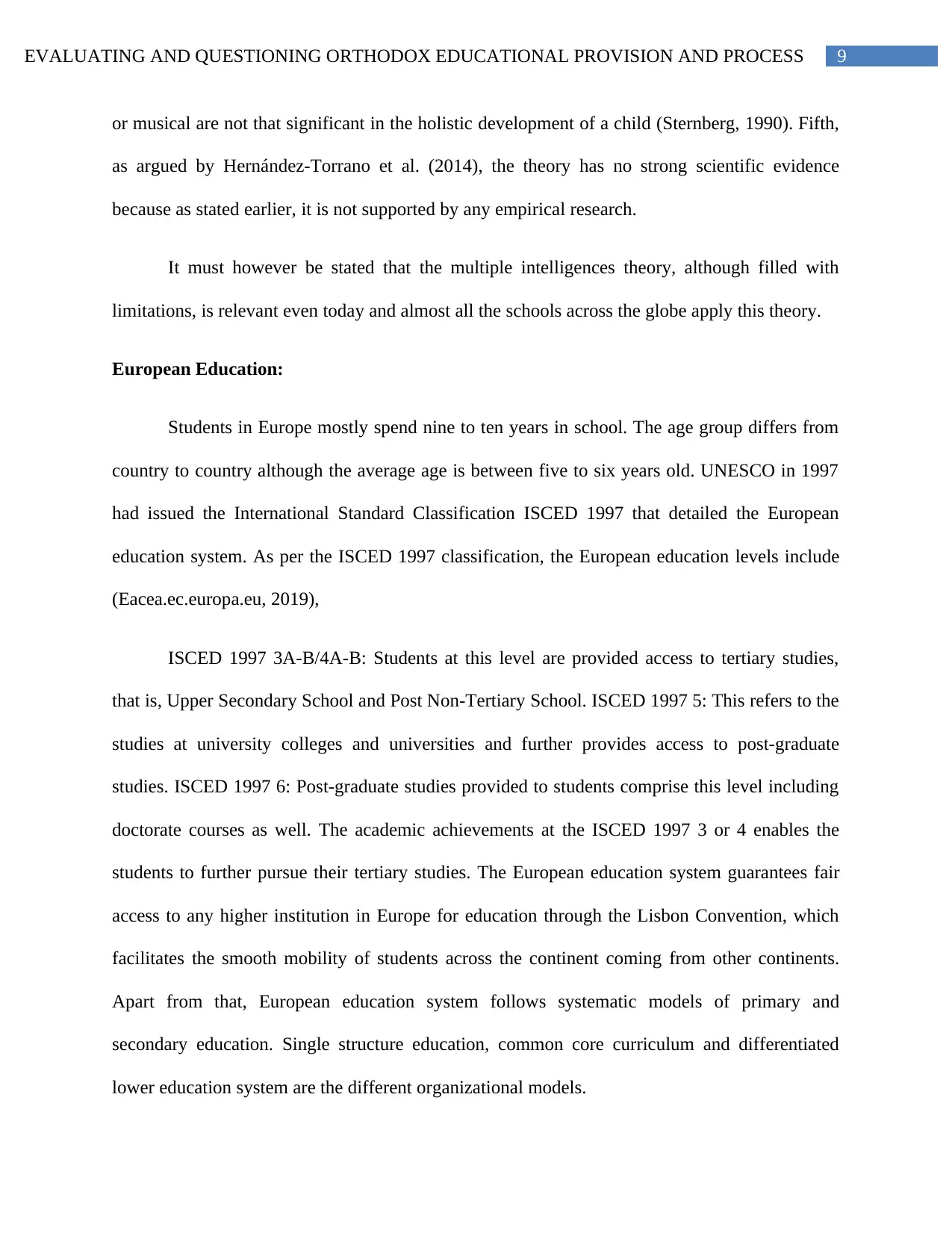
9EVALUATING AND QUESTIONING ORTHODOX EDUCATIONAL PROVISION AND PROCESS
or musical are not that significant in the holistic development of a child (Sternberg, 1990). Fifth,
as argued by Hernández-Torrano et al. (2014), the theory has no strong scientific evidence
because as stated earlier, it is not supported by any empirical research.
It must however be stated that the multiple intelligences theory, although filled with
limitations, is relevant even today and almost all the schools across the globe apply this theory.
European Education:
Students in Europe mostly spend nine to ten years in school. The age group differs from
country to country although the average age is between five to six years old. UNESCO in 1997
had issued the International Standard Classification ISCED 1997 that detailed the European
education system. As per the ISCED 1997 classification, the European education levels include
(Eacea.ec.europa.eu, 2019),
ISCED 1997 3A-B/4A-B: Students at this level are provided access to tertiary studies,
that is, Upper Secondary School and Post Non-Tertiary School. ISCED 1997 5: This refers to the
studies at university colleges and universities and further provides access to post-graduate
studies. ISCED 1997 6: Post-graduate studies provided to students comprise this level including
doctorate courses as well. The academic achievements at the ISCED 1997 3 or 4 enables the
students to further pursue their tertiary studies. The European education system guarantees fair
access to any higher institution in Europe for education through the Lisbon Convention, which
facilitates the smooth mobility of students across the continent coming from other continents.
Apart from that, European education system follows systematic models of primary and
secondary education. Single structure education, common core curriculum and differentiated
lower education system are the different organizational models.
or musical are not that significant in the holistic development of a child (Sternberg, 1990). Fifth,
as argued by Hernández-Torrano et al. (2014), the theory has no strong scientific evidence
because as stated earlier, it is not supported by any empirical research.
It must however be stated that the multiple intelligences theory, although filled with
limitations, is relevant even today and almost all the schools across the globe apply this theory.
European Education:
Students in Europe mostly spend nine to ten years in school. The age group differs from
country to country although the average age is between five to six years old. UNESCO in 1997
had issued the International Standard Classification ISCED 1997 that detailed the European
education system. As per the ISCED 1997 classification, the European education levels include
(Eacea.ec.europa.eu, 2019),
ISCED 1997 3A-B/4A-B: Students at this level are provided access to tertiary studies,
that is, Upper Secondary School and Post Non-Tertiary School. ISCED 1997 5: This refers to the
studies at university colleges and universities and further provides access to post-graduate
studies. ISCED 1997 6: Post-graduate studies provided to students comprise this level including
doctorate courses as well. The academic achievements at the ISCED 1997 3 or 4 enables the
students to further pursue their tertiary studies. The European education system guarantees fair
access to any higher institution in Europe for education through the Lisbon Convention, which
facilitates the smooth mobility of students across the continent coming from other continents.
Apart from that, European education system follows systematic models of primary and
secondary education. Single structure education, common core curriculum and differentiated
lower education system are the different organizational models.
Paraphrase This Document
Need a fresh take? Get an instant paraphrase of this document with our AI Paraphraser
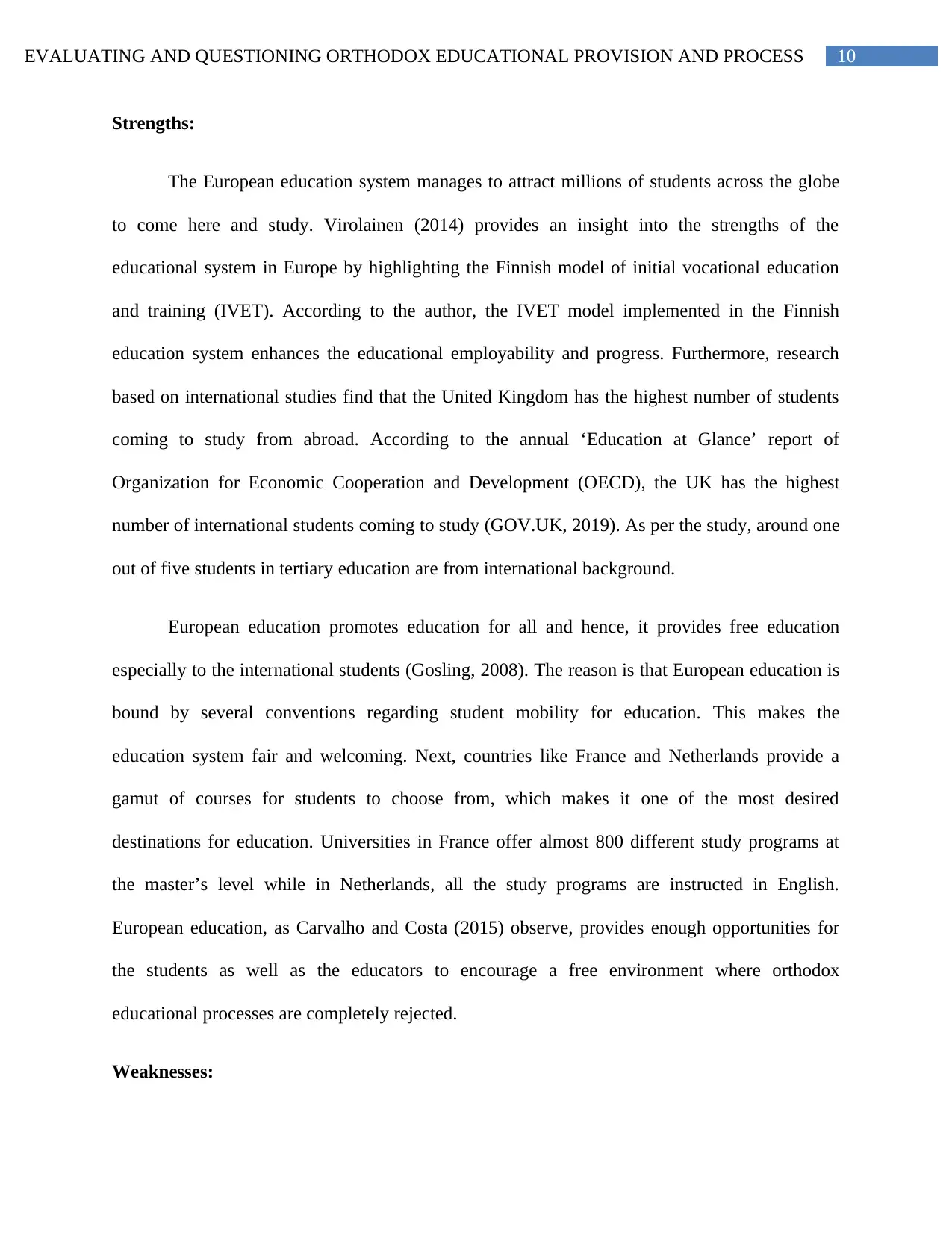
10EVALUATING AND QUESTIONING ORTHODOX EDUCATIONAL PROVISION AND PROCESS
Strengths:
The European education system manages to attract millions of students across the globe
to come here and study. Virolainen (2014) provides an insight into the strengths of the
educational system in Europe by highlighting the Finnish model of initial vocational education
and training (IVET). According to the author, the IVET model implemented in the Finnish
education system enhances the educational employability and progress. Furthermore, research
based on international studies find that the United Kingdom has the highest number of students
coming to study from abroad. According to the annual ‘Education at Glance’ report of
Organization for Economic Cooperation and Development (OECD), the UK has the highest
number of international students coming to study (GOV.UK, 2019). As per the study, around one
out of five students in tertiary education are from international background.
European education promotes education for all and hence, it provides free education
especially to the international students (Gosling, 2008). The reason is that European education is
bound by several conventions regarding student mobility for education. This makes the
education system fair and welcoming. Next, countries like France and Netherlands provide a
gamut of courses for students to choose from, which makes it one of the most desired
destinations for education. Universities in France offer almost 800 different study programs at
the master’s level while in Netherlands, all the study programs are instructed in English.
European education, as Carvalho and Costa (2015) observe, provides enough opportunities for
the students as well as the educators to encourage a free environment where orthodox
educational processes are completely rejected.
Weaknesses:
Strengths:
The European education system manages to attract millions of students across the globe
to come here and study. Virolainen (2014) provides an insight into the strengths of the
educational system in Europe by highlighting the Finnish model of initial vocational education
and training (IVET). According to the author, the IVET model implemented in the Finnish
education system enhances the educational employability and progress. Furthermore, research
based on international studies find that the United Kingdom has the highest number of students
coming to study from abroad. According to the annual ‘Education at Glance’ report of
Organization for Economic Cooperation and Development (OECD), the UK has the highest
number of international students coming to study (GOV.UK, 2019). As per the study, around one
out of five students in tertiary education are from international background.
European education promotes education for all and hence, it provides free education
especially to the international students (Gosling, 2008). The reason is that European education is
bound by several conventions regarding student mobility for education. This makes the
education system fair and welcoming. Next, countries like France and Netherlands provide a
gamut of courses for students to choose from, which makes it one of the most desired
destinations for education. Universities in France offer almost 800 different study programs at
the master’s level while in Netherlands, all the study programs are instructed in English.
European education, as Carvalho and Costa (2015) observe, provides enough opportunities for
the students as well as the educators to encourage a free environment where orthodox
educational processes are completely rejected.
Weaknesses:
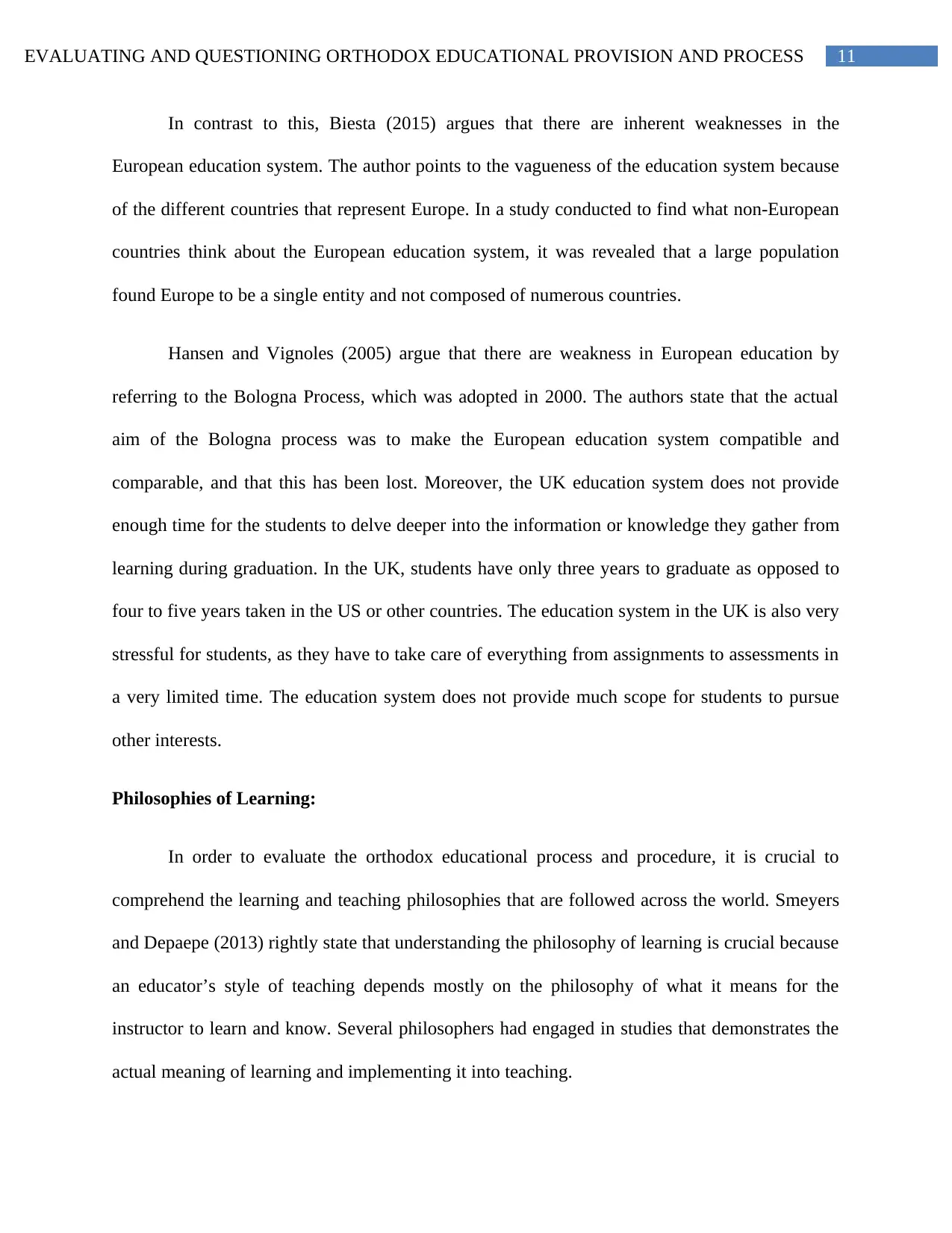
11EVALUATING AND QUESTIONING ORTHODOX EDUCATIONAL PROVISION AND PROCESS
In contrast to this, Biesta (2015) argues that there are inherent weaknesses in the
European education system. The author points to the vagueness of the education system because
of the different countries that represent Europe. In a study conducted to find what non-European
countries think about the European education system, it was revealed that a large population
found Europe to be a single entity and not composed of numerous countries.
Hansen and Vignoles (2005) argue that there are weakness in European education by
referring to the Bologna Process, which was adopted in 2000. The authors state that the actual
aim of the Bologna process was to make the European education system compatible and
comparable, and that this has been lost. Moreover, the UK education system does not provide
enough time for the students to delve deeper into the information or knowledge they gather from
learning during graduation. In the UK, students have only three years to graduate as opposed to
four to five years taken in the US or other countries. The education system in the UK is also very
stressful for students, as they have to take care of everything from assignments to assessments in
a very limited time. The education system does not provide much scope for students to pursue
other interests.
Philosophies of Learning:
In order to evaluate the orthodox educational process and procedure, it is crucial to
comprehend the learning and teaching philosophies that are followed across the world. Smeyers
and Depaepe (2013) rightly state that understanding the philosophy of learning is crucial because
an educator’s style of teaching depends mostly on the philosophy of what it means for the
instructor to learn and know. Several philosophers had engaged in studies that demonstrates the
actual meaning of learning and implementing it into teaching.
In contrast to this, Biesta (2015) argues that there are inherent weaknesses in the
European education system. The author points to the vagueness of the education system because
of the different countries that represent Europe. In a study conducted to find what non-European
countries think about the European education system, it was revealed that a large population
found Europe to be a single entity and not composed of numerous countries.
Hansen and Vignoles (2005) argue that there are weakness in European education by
referring to the Bologna Process, which was adopted in 2000. The authors state that the actual
aim of the Bologna process was to make the European education system compatible and
comparable, and that this has been lost. Moreover, the UK education system does not provide
enough time for the students to delve deeper into the information or knowledge they gather from
learning during graduation. In the UK, students have only three years to graduate as opposed to
four to five years taken in the US or other countries. The education system in the UK is also very
stressful for students, as they have to take care of everything from assignments to assessments in
a very limited time. The education system does not provide much scope for students to pursue
other interests.
Philosophies of Learning:
In order to evaluate the orthodox educational process and procedure, it is crucial to
comprehend the learning and teaching philosophies that are followed across the world. Smeyers
and Depaepe (2013) rightly state that understanding the philosophy of learning is crucial because
an educator’s style of teaching depends mostly on the philosophy of what it means for the
instructor to learn and know. Several philosophers had engaged in studies that demonstrates the
actual meaning of learning and implementing it into teaching.
⊘ This is a preview!⊘
Do you want full access?
Subscribe today to unlock all pages.

Trusted by 1+ million students worldwide
1 out of 24
Your All-in-One AI-Powered Toolkit for Academic Success.
+13062052269
info@desklib.com
Available 24*7 on WhatsApp / Email
![[object Object]](/_next/static/media/star-bottom.7253800d.svg)
Unlock your academic potential
Copyright © 2020–2025 A2Z Services. All Rights Reserved. Developed and managed by ZUCOL.